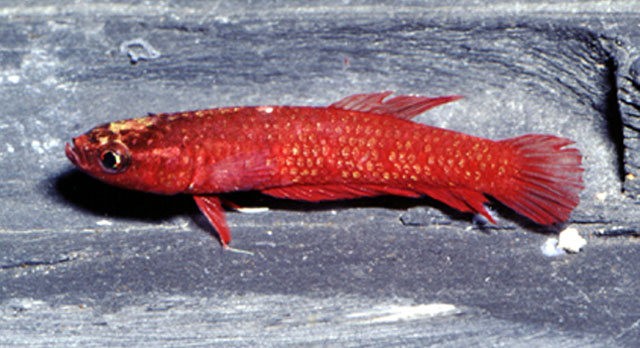| Osphronemidae (Gouramies), subfamily: Macropodusinae |
| 3.5 cm TL (male/unsexed) |
|
benthopelagic; freshwater |
| Asia: Indonesia. |
|
Belongs to the Betta coccina complex which is distinguished by having only 9 abdominal vertebrae (vs. 10-11 in all other Betta) and usually a deep red color. Within this complex, Betta persephone is distinguished by its blackish coloration. Betta rutilans shares with Betta tussyae, a modal dorsal ray count of 12 (vs. 10 and 11 in other species of the complex), a modal subdorsal scale count of 9 (vs. 7), a greater length of dorsal base (20-23% SL, vs. 14-19), absence of a midlateral blotch (vs. usually present in male Betta coccina and Betta sp. Witte & Schmidt, submitted) and white pelvic filament (vs. black in Betta coccina). Betta rutilans differs from Betta tussyae by a lower mode in dorsal (I, vs. II) and anal spines (II, vs. III), smaller size (up to 25 mm SL, vs. 48, aquarium specimens), and absence of bluish green spots on proximal areas of unpaired fins (vs. usually present). The single cleared and stained specimens is apparently distinguished from all other Betta by having fused hypurals 6 and 7 (Ref. 26721). |
|
|
Critically Endangered (CR); Date assessed: 13 January 2019 (B2ab(iii)) Ref. (130435)
|
| harmless |
Source and more info: www.fishbase.org. For personal, classroom, and other internal use only. Not for publication.

